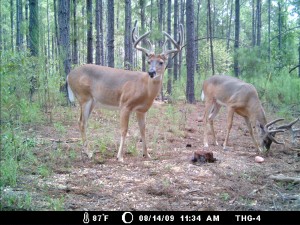
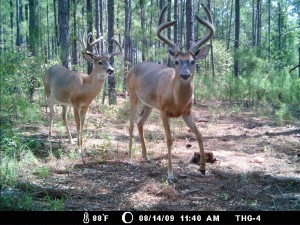
Every hunter by now has heard of trail cameras and chances are that most of you are currently using them. I use them for all of my hunting ventures and I wanted to discuss some of the pros and cons of using them.
The Good – Affordable trail cameras became available for hunting about 5 years ago. At first, there were only a few manufacturers making these cameras with few models to choose from. Now, there are dozens of manufacturers with even more cameras on the market. These cameras have constantly gone down in price while their performance and functionality have increased many times since the earlier models. The original versions were filmed camera where you had to take them in for photo development but they quickly evolved to all digital cameras with portable storage medium to be viewed on a computer. Now, they have even introduced new models that can send photos over the cellular network to you while you are at home via email or text message to your cellular phone.
A need for a motion based camera first came about during the beginning of the quality deer management movement over 30 years ago. Wildlife biologists needed a way to perform research through photos. Some of the first cameras were crude and worked only part of the time but with any new technology they have kept evolving to give us the technologically advanced cameras we have today.
So with that history in mind, trail cameras are used to detect what game you have on your property. This information can be critical in determining such things as deer density (deer/square mile), body size (determines health), and the sex ratio of does to bucks or gobblers to hens. These are critical components in any type of quality management program.
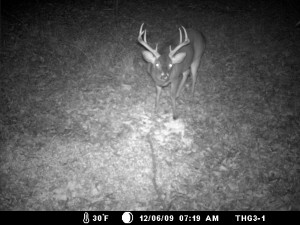
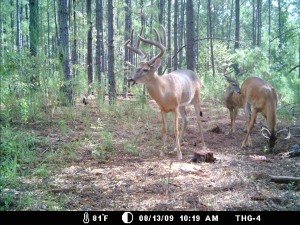
The most common way a good management program will use trail cameras is to take a census before deer season with cameras placed every 100 acres over some type of attractant for a couple of weeks. Then the photos would be viewed and the information recorded. Then after deer season, another census is taken recording the same information. Most biologists recommend a census twice a year.
Another good use of trail cameras is to document which deer you want to shoot and which ones you want to live. I have seen photo albums at deer camps that I have visited with what they called “The Hit List” containing the deer they wanted to harvest.
In my opinion most deer hunters buy cameras to pattern deer. They want to know what kind of deer and what time do they come by my deer stand, food plot, etc… I think of my cameras as hunting for me when I cannot be there. They are much more patient and as long as I have fresh batteries and an empty memory card, they will hunt hard for me. It is like Christmas morning when you get the memory card back and start looking through the photos and finding a new buck you have never seen.
Setting up trail cameras to capture deer pictures is also a challenge. It is a fun way to pass the time during the off season that can lead to benefits during the hunting season. There is an art and science to setting them up and experience comes with trial and error. I can tell you stories about how I had the most perfect setup and when I came back 3 weeks later, I realized I forgot to turn the camera on or a bush waved back and forth in front of the infrared sensor filling up my memory card or something dumb like that. Oh, the stories I could tell.
The Bad – I have come to witness two bad things while using my trail cameras. 5 years ago when I first started using them I would find myself wanting to check the cameras every day for new pictures. I had to literally go into withdrawal to break this habit. I was finding that when I checked them every day I was disturbing the area with noise and scent and later when I hunted it, I was not seeing the deer I once saw before. I was trying to use my cameras to pattern deer but in return my obsessive behavior of checking the cameras were causing me to be patterned by the deer. This was a bad way to use this technology. So now when I check my cameras, I am normally going to hunt that location and I will check the camera after I get through hunting or if I have been gone for a period of time, I will check my cameras during the midday when the deer are normally bedded down to see what spots I want to hunt later.
Here is an example of the second bad way to use them. I had a good spot over a food plot where I normally placed one of my trail cameras. This spot had always been productive but this year, every time I checked the camera; there were only a few photos of deer. Instead of looking at tracks and other signs, I assumed that the deer were not attracted to that food plot and I chose not to invest my time hunting that location. Well, at the end of the season when I was pulling my cameras out, I noticed that the camera was not taking my picture when I walked up to it. Low and behold, the motion sensor was broken and was not taking pictures 90% of the time. I looked around and sure enough the food plot had been grazed like cows and there were rubs and scrapes all around with a couple of big ole’ buck tracks. The Bad was that I trusted my camera and forgot about all the other good woodsmanship that I had learned over the years causing me to neglect a great spot. Needless to say, I did not let that happen anymore. Trail cameras are to be used as a tool in conjunction with other scouting techniques but like life, I had to learn the hard way.
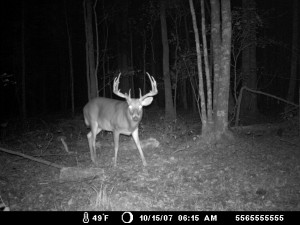
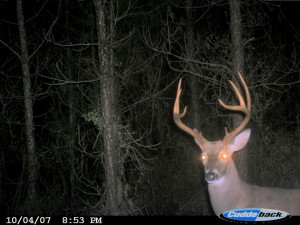
The Ugly – Now that you now my opinions on the Good and the Bad of trail cameras, let me talk about the Ugly. What could possibly be Ugly about trail cameras? Nothing is Ugly about the cameras, just the photos they take. I can remember a time the only way you knew a big buck was in an area was to see his track or rub tree or actually see him. I like to think that ignorance was bliss back then when I was sitting on a stand waiting. But now you have photographic proof that a big buck was there and that he was a 10 point that could score 145” B.C. He has been at your food plot every evening right before dark. Then you start thinking, if I go today and the rest of the week, he will most likely be there. I do not care how many times I have hunted that stand. I don’t care the wind is wrong. I am dying because I have to be at work instead of on that stand. If I could just hunt that location, I can get that deer. These kinds of statements can make you obsessed, even crazy. This is the Ugly. I have seen people walk around with the photos in their pockets and even on their phones. I must confess that I am guilty of this. It is true that one picture is worth a thousand words but one trail camera picture of a big buck can consume the everyday thoughts of a hunter to the point of obsession.
Let me give you an example of this Ugly in action. I was working one summer on getting my hunting lease ready for deer season. I got a picture of a huge 10 point that later scored 144” B.C. I became obsessed with this deer. I named him and did everything possible to get ready to hunt him. Opening day of deer season came around and went and I could not get a shot at this deer. The trail camera photos made me feel like this deer was for me to take. About 3 weeks into the season, a good buddy on my lease ½ mile away from where I had been getting the pictures of the one I wanted called me and said he had killed a big buck. I went to help him load it up and I was all excited for him and low and behold it was the deer I was after. I was heartbroken and depressed at first but then I was later relieved to know that the pressure was off. This whole situation was definitely Ugly to me.
Would I do it again? You better believe it. I would rather go through the agony of knowing that a big buck is in the area than to go in it blind. Knowing that a big buck was there put spring in my step when I got up in the mornings. It made me hunt a little longer and get on the stand a little earlier. It made me hunt harder paying attention to the little details. Later that season I took two nice bucks and I believe that obsessive hunting over one buck made me a better hunter for the later success.
So in conclusion, I recommend using trail cameras but keep these points in mind when setting them up, and if you get a picture of that big buck, try to get a good night’s sleep and stay sane when hunting them. Trail cameras have proven to be a powerful tool in my hunting arsenal but remember to walk that fine line between sanity and obsession. Good luck!